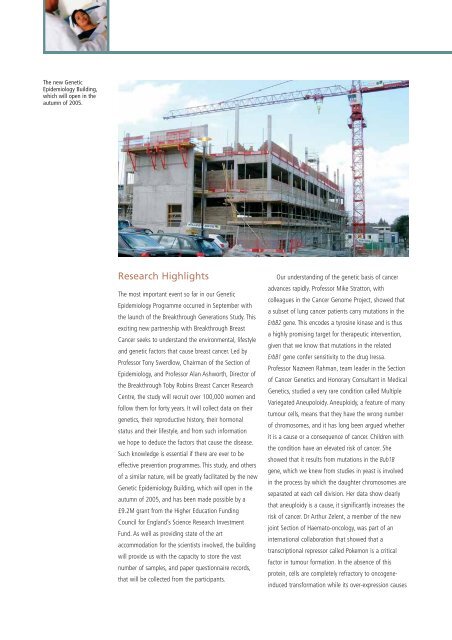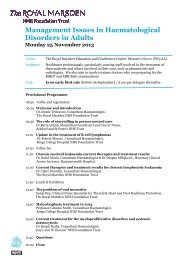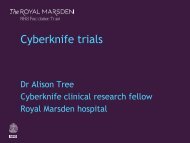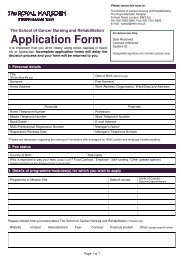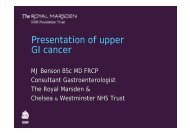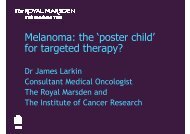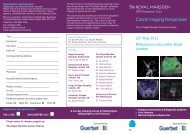Joint Annual Research Report 2004 - The Royal Marsden
Joint Annual Research Report 2004 - The Royal Marsden
Joint Annual Research Report 2004 - The Royal Marsden
You also want an ePaper? Increase the reach of your titles
YUMPU automatically turns print PDFs into web optimized ePapers that Google loves.
<strong>The</strong> new Genetic<br />
Epidemiology Building,<br />
which will open in the<br />
autumn of 2005.<br />
<strong>Research</strong> Highlights<br />
<strong>The</strong> most important event so far in our Genetic<br />
Epidemiology Programme occurred in September with<br />
the launch of the Breakthrough Generations Study. This<br />
exciting new partnership with Breakthrough Breast<br />
Cancer seeks to understand the environmental, lifestyle<br />
and genetic factors that cause breast cancer. Led by<br />
Professor Tony Swerdlow, Chairman of the Section of<br />
Epidemiology, and Professor Alan Ashworth, Director of<br />
the Breakthrough Toby Robins Breast Cancer <strong>Research</strong><br />
Centre, the study will recruit over 100,000 women and<br />
follow them for forty years. It will collect data on their<br />
genetics, their reproductive history, their hormonal<br />
status and their lifestyle, and from such information<br />
we hope to deduce the factors that cause the disease.<br />
Such knowledge is essential if there are ever to be<br />
effective prevention programmes. This study, and others<br />
of a similar nature, will be greatly facilitated by the new<br />
Genetic Epidemiology Building, which will open in the<br />
autumn of 2005, and has been made possible by a<br />
£9.2M grant from the Higher Education Funding<br />
Council for England’s Science <strong>Research</strong> Investment<br />
Fund. As well as providing state of the art<br />
accommodation for the scientists involved, the building<br />
will provide us with the capacity to store the vast<br />
number of samples, and paper questionnaire records,<br />
that will be collected from the participants.<br />
Our understanding of the genetic basis of cancer<br />
advances rapidly. Professor Mike Stratton, with<br />
colleagues in the Cancer Genome Project, showed that<br />
a subset of lung cancer patients carry mutations in the<br />
ErbB2 gene. This encodes a tyrosine kinase and is thus<br />
a highly promising target for therapeutic intervention,<br />
given that we know that mutations in the related<br />
ErbB1 gene confer sensitivity to the drug Iressa.<br />
Professor Nazneen Rahman, team leader in the Section<br />
of Cancer Genetics and Honorary Consultant in Medical<br />
Genetics, studied a very rare condition called Multiple<br />
Variegated Aneupoloidy. Aneuploidy, a feature of many<br />
tumour cells, means that they have the wrong number<br />
of chromosomes, and it has long been argued whether<br />
it is a cause or a consequence of cancer. Children with<br />
the condition have an elevated risk of cancer. She<br />
showed that it results from mutations in the Bub1B<br />
gene, which we knew from studies in yeast is involved<br />
in the process by which the daughter chromosomes are<br />
separated at each cell division. Her data show clearly<br />
that aneuploidy is a cause, it significantly increases the<br />
risk of cancer. Dr Arthur Zelent, a member of the new<br />
joint Section of Haemato-oncology, was part of an<br />
international collaboration that showed that a<br />
transcriptional repressor called Pokemon is a critical<br />
factor in tumour formation. In the absence of this<br />
protein, cells are completely refractory to oncogeneinduced<br />
transformation while its over-expression causes


